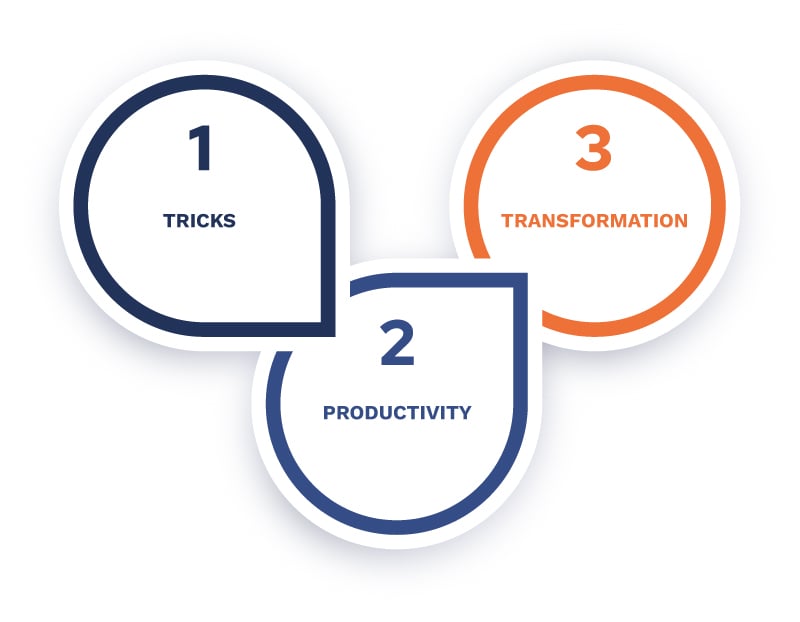The MSP Transformation Crisis: Why Waiting Is No Longer an Option
The numbers don't lie. MSP ticket volumes have exploded 40% over the past two years, while resolution times have actually gotten longer. Your team is...
Get everything you need for the ultimate client experience
Enterprise-grade infrastructure with the flexibility MSPs demand
Deliver instant, accurate answers that can help achieve zero-touch resolution
Perfectly tailored AI that knows your specific MSP

Build your own Shopify-like store with your PSA products & distributors
Have clients to submit tickets directly to your PSA, freeing up your team's time
You'll learn things like how to add revenue without adding cost, MSP best practices, and how to master client management.
5 min read
 CloudRadial
:
July 29, 2025
CloudRadial
:
July 29, 2025

Every MSP's AI journey begins the same way. Someone on the team tries ChatGPT for the first time, marvels at its ability to write emails in the style of a pirate, and suddenly everyone's talking about using AI for everything. But six months later, that same enthusiasm often fades into doubt as teams struggle to move beyond novelty applications to create real business value.
This pattern isn't unique to MSPs—it's happening across industries as organizations grapple with the gap between AI's promise and its practical implementation. The challenge isn't that AI lacks transformative potential; it's that most businesses get stuck in the early stages of adoption, never progressing to where AI can fundamentally reshape how they operate.
Understanding the three distinct stages of AI adoption can help MSPs navigate this journey more strategically, avoiding common pitfalls while building toward truly transformative implementations that don't just improve efficiency—they redefine what's possible for service delivery.
Are you curious to know what true MSP transformation will look like?
Don't miss our "MSP Transformation is Coming to CloudRadial" event.
The first stage of AI adoption is characterized by experimentation and wonder. Team members discover they can ask AI to write emails in different tones, generate creative content, or solve abstract problems in entertaining ways. This phase serves an important purpose—it demystifies AI and builds familiarity with the technology—but it rarely delivers measurable business value.
In MSP environments, this might look like using AI to write more colorful incident reports, generate witty out-of-office messages, or create team-building content. While these applications can boost morale and demonstrate AI's versatility, they don't address core operational challenges or client needs.
The Limitation of Tricks
The fundamental problem with staying in the tricks phase is that novelty wears off quickly. What seems impressive initially becomes routine, and without clear business applications, AI tools get abandoned. Teams may conclude that AI is "overhyped" or "not ready for serious business use," missing the opportunity to explore more valuable implementations.
Many MSPs plateau here because they lack a framework for identifying practical applications or because early experiments don't produce obvious ROI. Without proper guidance, it's easy to dismiss AI as a technological curiosity rather than recognizing it as a stepping stone toward more sophisticated uses.
Moving Beyond Tricks
The key to progressing beyond this stage is shifting focus from entertainment to utility. Instead of asking "What can AI do that's interesting?" the question becomes "What repetitive or time-consuming tasks could AI handle more efficiently?" This mindset shift opens the door to the productivity stage, where AI begins delivering tangible business value.
The productivity stage represents AI's sweet spot for most current implementations. Here, AI tools become practical assistants that help teams work faster, communicate more effectively, and handle routine tasks with greater consistency. The focus shifts from novelty to measurable gains in efficiency and output quality.
Practical Applications for MSPs
In the productivity phase, MSPs typically implement AI for tasks like drafting client communications, generating technical documentation, creating knowledge base articles, and analyzing log files for common issues. These applications deliver clear time savings and often improve the quality of outputs by providing structure, consistency, and professional polish.
For example, instead of spending 30 minutes crafting a detailed incident report, a technician might use AI to generate a comprehensive draft in 3 minutes, then spend 5 minutes reviewing and customizing it. The net result is a 20-minute time saving plus a more thorough, professionally written report.
Documentation and Knowledge Management
One of the most impactful productivity applications is automated documentation generation. AI can analyze support interactions to create troubleshooting guides, update network diagrams based on configuration changes, and generate client-specific procedural documentation. This addresses one of MSPs' biggest operational challenges while creating valuable assets for future use.
Similarly, AI-powered search and recommendation systems help technicians quickly find relevant information during support incidents. Instead of manually searching through documentation repositories, technicians can describe their current situation and receive contextually relevant resources, procedures, and historical solutions.
The Productivity Plateau
While the productivity stage delivers more value, it also represents a natural plateau for many organizations. Teams achieve meaningful efficiency gains and improved output quality, but they're still fundamentally doing the same work—just faster and better. AI remains a tool that enhances human work rather than transforming how work gets done.
This stage is characterized by linear improvements: 20% faster ticket resolution, 30% better documentation, 15% more consistent client communications. These gains are valuable and measurable, but they don't fundamentally change business models or create new competitive advantages.
Eager to see what AI for transformation looks like? Don't miss our reveal on September 17!
The transformation stage represents AI's ultimate potential—systems that don't just assist with existing processes but fundamentally reshape how businesses operate. This is where AI transitions from being a productivity tool to becoming an integrated intelligence that learns from operations, adapts to changing conditions, and enables entirely new service delivery models.
Learning and Adaptive Systems
Transformational AI implementations are characterized by their ability to learn continuously from organizational data and improve performance over time. Unlike productivity tools that apply the same capabilities repeatedly, transformational systems become more valuable as they accumulate experience and understanding of specific business contexts.
For MSPs, this might manifest as AI systems that learn from every support interaction to become better at predicting issues, recommending solutions, and understanding client-specific needs. These systems don't just help resolve tickets faster—they begin to prevent issues from occurring in the first place by recognizing patterns that humans might miss.
Predictive and Proactive Operations
True transformation occurs when AI enables MSPs to shift from reactive support models to predictive, proactive service delivery. Instead of waiting for clients to report problems, AI systems analyze patterns across network performance, user behavior, and historical incidents to identify potential issues weeks or months in advance.
This capability transforms the MSP value proposition from "we'll fix your problems quickly" to "we'll prevent your problems from occurring." Such a shift fundamentally changes client relationships, pricing models, and competitive positioning in ways that productivity improvements alone cannot achieve.
Organizational Intelligence
At the transformation stage, AI becomes embedded in the organization's decision-making processes, not just its operational tasks. AI systems provide strategic insights about client satisfaction trends, resource allocation optimization, and business development opportunities based on comprehensive analysis of operational data.
This organizational intelligence enables MSPs to make more informed decisions about everything from staffing and training to service offerings and pricing strategies. The AI system offers strategic advice based on a deep understanding of your MSP and can recommend actions that humans might not consider or have time to analyze.
New Service Models and Revenue Streams
Perhaps most importantly, transformational AI enables entirely new service models that weren't previously feasible. MSPs can offer service structures, outcome-driven pricing, or highly specialized consulting based on AI-generated insights that would be impossible to develop manually.
These new models create differentiated value propositions and open additional revenue streams while potentially commanding premium pricing. Clients aren't just paying for technical support—they're paying for intelligence, prediction, and transformation of their own operations.
The distinction between productivity and transformation isn't just philosophical—it requires fundamentally different approaches to AI implementation. While general-purpose AI tools excel at productivity applications, achieving transformation requires specialized systems designed specifically for service delivery contexts.
The next generation of AI platforms will represent this transformation-focused approach, building systems that don't just help MSPs work more efficiently but fundamentally change how they deliver service to clients. By focusing on learning from your historical data, training teams, and transforming delivery models, these purpose-built solutions will enable MSPs to skip the common plateau and move directly toward transformational implementations.
The question for every MSP isn't whether to adopt AI, but how quickly they can progress through the three stages to reach transformation before their competitors do. The MSPs that master transformational AI adoption will define the future of managed services, while those that remain stuck in earlier stages risk being left behind.
The journey from tricks to transformation isn't always linear, and different parts of an organization may be at different stages simultaneously. However, understanding these phases provides a roadmap for strategic AI adoption that maximizes value while avoiding common pitfalls. For MSPs ready to move beyond productivity gains toward genuine transformation, the opportunity has never been greater—but the window for competitive advantage won't remain open indefinitely.

The numbers don't lie. MSP ticket volumes have exploded 40% over the past two years, while resolution times have actually gotten longer. Your team is...

The Service Desk Crisis: Beyond the Surface Problems The average MSP service desk faces ticket volumes that have increased 40% over the past two...

Every MSP's AI journey begins the same way. Someone on the team tries ChatGPT for the first time, marvels at its ability to write emails in the style...